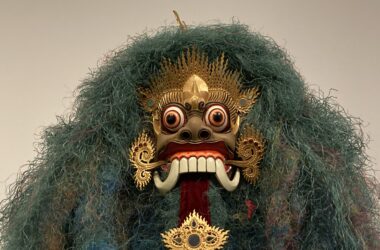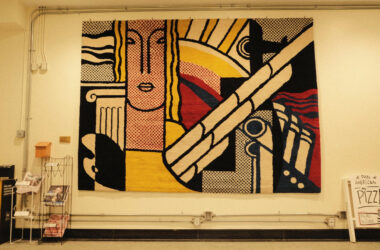The final room of Witches: Out of the Shadows is one of the most powerful exhibition endings I have ever witnessed. Kiki Smith’s bronze sculpture Woman on Pyre lies atop the centre pedestal, engulfed by a circular structure of distorted, geometric mirrors; it confronts the senses, inviting viewers to witness an execution scene frozen in time by its cast medium. Just because a pinprick drew no blood, the figure now kneels atop serrated logs that gnaw at her legs’ flesh, tearing through her barren form that helplessly pleads for mercy. At first glance, one could ask how a woman so vilified by the public as a violent figure hunches over in desolate surrender to her fate, but the motion of her outstretched arms beckoning for a final sliver of forgiveness takes the shape of a spirited resistance. She rises from her damnation as an accused witch, asserting resilience and fortitude even in death. Smith’s work bears witness to these silenced narratives of the demarcated witch, capturing the essence of this spirited exhibition.
Pointe-à-Callière’s exhibition Witches: Out of the Shadows considers the witch both as a historical construct rooted in sexism, and as a contemporary popular symbol of combined strength and folly. With its wondrous collection of diverse objects—scientific manuscripts, ritual accompaniments, tarot cards, and couture fashion, and more—the exhibit beautifully depicts the continuously remoulded perception of this mystical being. The jewel tones that cascade down from the walls accentuate witchcraft’s artistic nature, reasserting the ephemeral beauty of these historical items.
The exhibition begins with the genesis of the witch as a religious symbol of the blasphemous unknown and heretical magic. It then investigates its subsequent transformation into a secular vision of women’s disobedience in the Middle Ages as a perceived threat to the man-dominated sphere of science. Portrayed through manuscripts, medieval woodcuts, and manuals for witch elimination, the room artfully curates a glimpse into the world of intense paranoia of women’s power. Anything unknown to man, such as the woman-dominated world of natural healing and midwifery, would be deemed “otherworldly” and therefore indicative of wicked intentions. We see the torture devices reserved for these so-called witches, and are forced to face this appalling history of subjugating women’s bodies to physical torture for scientific excellence.
Moving from room to room, the exhibit masterfully balances examples of women’s suffering with feminist reclamations of this violently circumscribed label. A dress by Alexander McQueen, titled In Memory of Elizabeth Howe, Salem, 1692, comments on the culture of traditional women’s practices, like textile design, and the use of structured garments as a form of armour. The piece builds off the hardships of ancestors to strengthen tenacity in a modern age where blatant inequalities still exist. Flanked by a 17th-century painting of the Salem Witch Trials and a tranquil video installation about witchcraft, the couture garment’s unexpected inclusion highlights this continuous presence of the feminine subject, not as victims but as demystified beings of enduring force.
The upper floor covers the dissemination of the “witch” into popular culture via urban legends, otherworldly games, and a process of spiritual protection through physical guidance. On display are antique Ouija boards, hand-painted tarot cards, religious amulets, and other modes of metaphysical connection. Projected onto the installation’s walls, the witch has taken shape across mediums as a misunderstood, beautified being who tirelessly revolts against hardship—and through power, reclaims her agency. Witches: Out of the Shadows brings light to this levelling of the perceived “cultural witch,” reminding attendees of the lengthy history of systemic expulsion and the subsequent revolution of the feminine spirit.
Witches: Out of the Shadows runs until Apr. 6, 2025. Tickets are available online or in person at Pointe-à-Callière.







